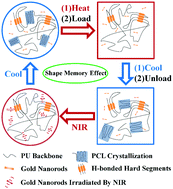Mechanically robust enzymatically degradable shape memory polyurethane urea with a rapid recovery response induced by NIR†
Abstract
Biodegradable shape memory polymers have great potential for use in minimally invasive surgical procedures. Herein, a series of shape memory polyurethanes (SMPUs) containing a chymotrypsin-inspired chain extender with adjustable mechanical properties and excellent shape memory effect (SME) was prepared successfully. The chemical structure, mechanical properties, SME and in vitro degradation of the PUs were systematically characterized by proton nuclear magnetic resonance spectroscopy, tensile testing, dynamic mechanical analysis under controlled force mode, and scanning electronic microscopy. By increasing the molecular weight of poly(ε-caprolactone) (PCL) and hard segment content, a PCL4000-based SMPU with a modulus value of 115 MPa was obtained, which is three times that of a PCL2000-based sample. Further, the modulus of the PCL4000-based SMPU was increased by 50% while that of the PCL2000-based SMPU was significantly reduced when temperature increased from 23 °C to 37 °C. In addition, the PCL4000-based SMPU exhibited excellent SME with the shape fixity ratio and recovery ratio almost reaching 100%. Gold nanorods were further incorporated into the PU matrix, endowing the materials with a fast near-infrared (NIR) response in 23 s for shape recovery (NIR wavelength of 808 nm, 1.5 W). Combined with enzymatic degradability, these PU/gold-nanorod composites exhibit great potential to be used in biodegradable shape memory expanding stents.



 Please wait while we load your content...
Please wait while we load your content...